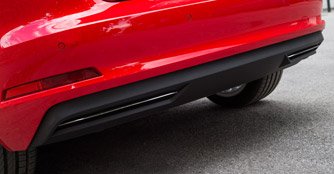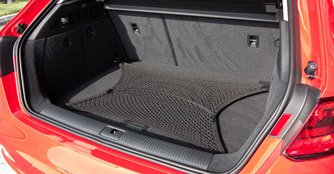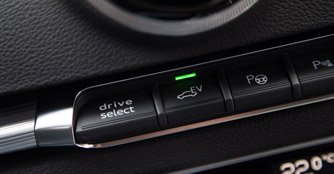Audi A3 e-tron (A) First Drive Review
04 Jul 2014|19,849 views
This car is the Audi A3 e-tron. For as long as we can remember, plug-in hybrids have been entirely separated from your everyday rides, regular hybrids included. But it seems like times are a changin'. The combination of advanced technologies and smart engineering has made these extraordinary cars unashamedly good to drive and desirable, with nary a geek magnetism factor in sight.
It's a long time coming we say, with carmakers marking their steps in having a cleaner future. BMW has the i3 and the i8 while Volkswagen has the e-Golf and the Golf GTE (which shares a similar powertrain hardware as the Audi shown here). Now, Audi is joining in the race with the A3 e-tron, although it's still unclear how much the car will roughly cost and when the car will arrive in Singapore next year.
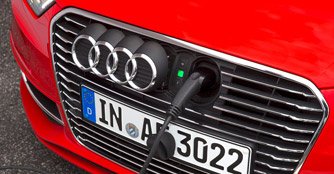
 Neatly concealed behind the four rings on its grille is the power socket to juice up the 8.8kWh lithium-ion battery pack
Neatly concealed behind the four rings on its grille is the power socket to juice up the 8.8kWh lithium-ion battery pack
That said, this premium eco-hatch should have no problems getting a rebate of $20k (with its emission of 35g/km of CO2) if the Carbon Emissions-Based Vehicle Scheme (CEVS) remains unrevised.
First unveiled in its concept form in Geneva last year, the Audi A3 e-tron is also based on Volkswagen Group's vastly versatile and supremely strategic Modular Transverse Matrix (MQB) platform - similar to the Mk7 Golf (which also includes the GTE plug-in hybrid).
It's a long time coming we say, with carmakers marking their steps in having a cleaner future. BMW has the i3 and the i8 while Volkswagen has the e-Golf and the Golf GTE (which shares a similar powertrain hardware as the Audi shown here). Now, Audi is joining in the race with the A3 e-tron, although it's still unclear how much the car will roughly cost and when the car will arrive in Singapore next year.

That said, this premium eco-hatch should have no problems getting a rebate of $20k (with its emission of 35g/km of CO2) if the Carbon Emissions-Based Vehicle Scheme (CEVS) remains unrevised.
First unveiled in its concept form in Geneva last year, the Audi A3 e-tron is also based on Volkswagen Group's vastly versatile and supremely strategic Modular Transverse Matrix (MQB) platform - similar to the Mk7 Golf (which also includes the GTE plug-in hybrid).
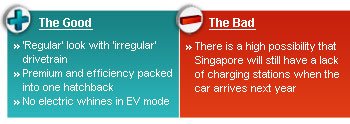 |
Exterior
Where plug-in hybrids like the BMW i8 and the Volkswagen GTE are designed to look more futuristic than their regular counterparts, the Audi A3 e-tron looks keenly close to the A3 Sportback.
As a matter of fact, at 4,312mm long, 1,785mm wide and 1,424mm tall, the A3 e-tron sports the same dimensions as its regular brethren. The only 'eco' differences are the badges, grille, aerodynamic wheels, bumpers and hidden exhaust outlets.
Hence, the eco hatch will probably look like an A3 Sportback to the casual observer, which isn't that bad a thing considering buyers of this car will most likely prioritise CO2 emissions over variant differentiation and can appreciate that less is more.
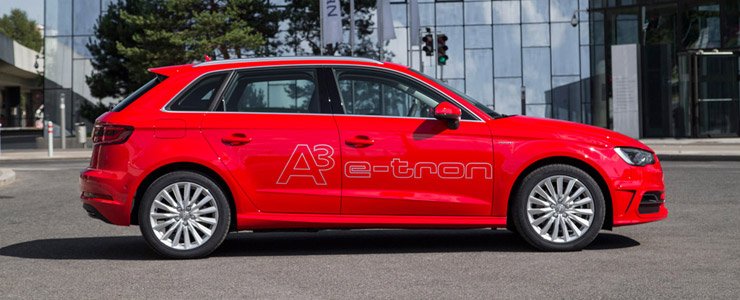 |
Interior
In here, the A3 e-tron retains its top quality materials and a very minimalistic and graceful design that will easily appeal to anyone of any age. Just like the regular A3 Sportback, the car also gets sufficient head and legroom for five occupants to travel in comfort (and style).
What's not like the regular model is the boot space, which has been downsized from 380 litres to 280 litres. You could, however, knock down the rear seats to form a larger-than-life cargo capacity of 1,120 litres. Ironically, this has nothing to do with the 125kg heavy battery pack because it rests under the rear seats, which allows for a superior handling characteristic.
In here, the A3 e-tron retains its top quality materials and a very minimalistic and graceful design that will easily appeal to anyone of any age. Just like the regular A3 Sportback, the car also gets sufficient head and legroom for five occupants to travel in comfort (and style).
What's not like the regular model is the boot space, which has been downsized from 380 litres to 280 litres. You could, however, knock down the rear seats to form a larger-than-life cargo capacity of 1,120 litres. Ironically, this has nothing to do with the 125kg heavy battery pack because it rests under the rear seats, which allows for a superior handling characteristic.
Where the e-tron differentiates its cabin from its petrol-driven sibling are through subtle 'e-tron' badges on the dash and door sills as well as an EV button (which allows you to toggle between four driving modes) that's located on the centre console.
Additionally, and perhaps the most significant difference, in place of the tachometer is a power meter that indicates key information such as the energy flow, battery status as well as a range monitor on both the combustion engine and the electric motor, which are clearly indicated via a yellow and green bar graph respectively.
Additionally, and perhaps the most significant difference, in place of the tachometer is a power meter that indicates key information such as the energy flow, battery status as well as a range monitor on both the combustion engine and the electric motor, which are clearly indicated via a yellow and green bar graph respectively.
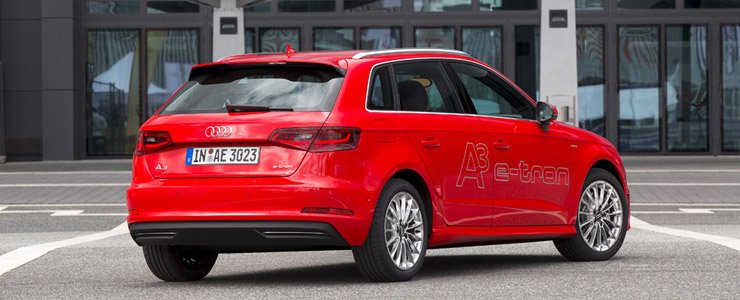 |
The Drive
The said four driving modes are EV, Hybrid, Hybrid Hold and Hybrid Charge. In EV mode, which is also the default driving mode, the car will cover up to 50km and on to a top speed of 130km/h. In fact, with 100bhp and a staggering 330Nm of torque, you could easily cruise around Singapore in pure electric mode without the need for the 1.4-litre combustion engine.
Unlike your everyday hybrid car, the combustion engine doesn't kick in so easily in the A3 e-tron. In fact, a kickdown is necessary to 'trigger' the Hybrid mode and when it does, it happens seamlessly with the sound of the combustion engine being the only indication that the driving mode has changed.
The engine is good for 150bhp and 250Nm of twisting force and when paired with the electric motor, it endows Audi's plug-in hybrid with a total system output of 204bhp and 350Nm of torque. Thus, the A3 e-tron will finish the century sprint in a reputable 7.6 seconds.
The said four driving modes are EV, Hybrid, Hybrid Hold and Hybrid Charge. In EV mode, which is also the default driving mode, the car will cover up to 50km and on to a top speed of 130km/h. In fact, with 100bhp and a staggering 330Nm of torque, you could easily cruise around Singapore in pure electric mode without the need for the 1.4-litre combustion engine.
Unlike your everyday hybrid car, the combustion engine doesn't kick in so easily in the A3 e-tron. In fact, a kickdown is necessary to 'trigger' the Hybrid mode and when it does, it happens seamlessly with the sound of the combustion engine being the only indication that the driving mode has changed.
The engine is good for 150bhp and 250Nm of twisting force and when paired with the electric motor, it endows Audi's plug-in hybrid with a total system output of 204bhp and 350Nm of torque. Thus, the A3 e-tron will finish the century sprint in a reputable 7.6 seconds.
It gets more interesting in Hybrid Charge. Regenerative braking may be the heaviest in this mode, which takes some adjusting. But, as the name suggests, this mode allows you to charge up the electric motor as quickly as possible while you're on the move.
Hybrid Hold, on the other hand, 'holds' the EV range from the battery and utilises only the combustion energy. Flicking the gear lever into 'S' can also activate this mode.
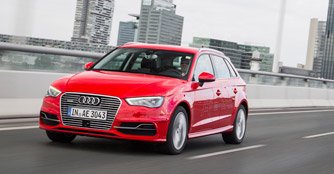
 The premium eco-friendly hatchback: where pure electric driving is more than sufficient to get you from point to point
The premium eco-friendly hatchback: where pure electric driving is more than sufficient to get you from point to point
Whatever the driving modes, the A3 e-tron never leaves you wanting. It's not blistering fast but its fun-to-drive characteristic is still there, plug-in hybrid or not. Credit has to go to the car's ability to take on corners with aplomb, thanks to the extra heft at the rear.
Hybrid Hold, on the other hand, 'holds' the EV range from the battery and utilises only the combustion energy. Flicking the gear lever into 'S' can also activate this mode.

Whatever the driving modes, the A3 e-tron never leaves you wanting. It's not blistering fast but its fun-to-drive characteristic is still there, plug-in hybrid or not. Credit has to go to the car's ability to take on corners with aplomb, thanks to the extra heft at the rear.
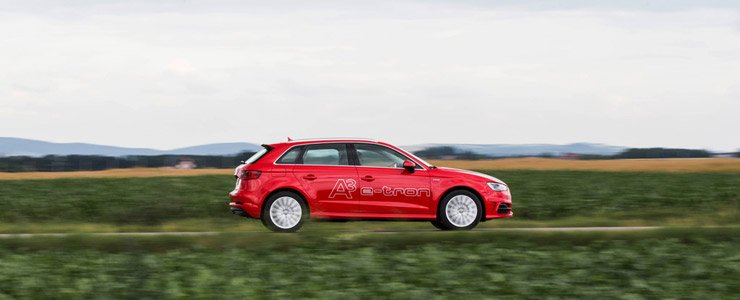 |
The brake pedal is well-modulated and feels every bit natural, instilling you with the confidence to go faster at every switchback. Of course having power moved to the front wheels could also cause you to understeer should you decide to breach the car's limits.
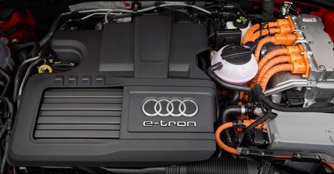
 The engine has been shifted about 60mm to the left compared to a regular A3 to accomodate additional components
The engine has been shifted about 60mm to the left compared to a regular A3 to accomodate additional components
During our drive in Vienna, we managed to cover close to 85km and according to a bespectacled guy with two hand phones, one huge monitor that comes with a cool-looking Bluetooth keyboard and two walkie-talkies (you get the point), a staggering 72 percent of our drive was emission-free.

During our drive in Vienna, we managed to cover close to 85km and according to a bespectacled guy with two hand phones, one huge monitor that comes with a cool-looking Bluetooth keyboard and two walkie-talkies (you get the point), a staggering 72 percent of our drive was emission-free.
Although we managed 22.7km/L during our time with the car, which is way off the claimed fuel consumption figure of 66.7km/L, you cannot deny such a figure deserves praise.
Conclusion
The Audi A3 e-tron is no doubt a more accessible approach to alternative mobility. It may not be revolutionary as, say, BMW i cars (considering it's a whole new sub-brand of BMW, with its cars consisting of the LifeDrive architecture) but it's a subtle statement that you can easily acquaint yourself and is, thus, much easier to live with on a daily basis.
Conclusion
The Audi A3 e-tron is no doubt a more accessible approach to alternative mobility. It may not be revolutionary as, say, BMW i cars (considering it's a whole new sub-brand of BMW, with its cars consisting of the LifeDrive architecture) but it's a subtle statement that you can easily acquaint yourself and is, thus, much easier to live with on a daily basis.
This car is the Audi A3 e-tron. For as long as we can remember, plug-in hybrids have been entirely separated from your everyday rides, regular hybrids included. But it seems like times are a changin'. The combination of advanced technologies and smart engineering has made these extraordinary cars unashamedly good to drive and desirable, with nary a geek magnetism factor in sight.
It's a long time coming we say, with carmakers marking their steps in having a cleaner future. BMW has the i3 and the i8 while Volkswagen has the e-Golf and the Golf GTE (which shares a similar powertrain hardware as the Audi shown here). Now, Audi is joining in the race with the A3 e-tron, although it's still unclear how much the car will roughly cost and when the car will arrive in Singapore next year.
That said, this premium eco-hatch should have no problems getting a rebate of $20k (with its emission of 35g/km of CO2) if the Carbon Emissions-Based Vehicle Scheme (CEVS) remains unrevised.
First unveiled in its concept form in Geneva last year, the Audi A3 e-tron is also based on Volkswagen Group's vastly versatile and supremely strategic Modular Transverse Matrix (MQB) platform - similar to the Mk7 Golf (which also includes the GTE plug-in hybrid).
It's a long time coming we say, with carmakers marking their steps in having a cleaner future. BMW has the i3 and the i8 while Volkswagen has the e-Golf and the Golf GTE (which shares a similar powertrain hardware as the Audi shown here). Now, Audi is joining in the race with the A3 e-tron, although it's still unclear how much the car will roughly cost and when the car will arrive in Singapore next year.
That said, this premium eco-hatch should have no problems getting a rebate of $20k (with its emission of 35g/km of CO2) if the Carbon Emissions-Based Vehicle Scheme (CEVS) remains unrevised.
First unveiled in its concept form in Geneva last year, the Audi A3 e-tron is also based on Volkswagen Group's vastly versatile and supremely strategic Modular Transverse Matrix (MQB) platform - similar to the Mk7 Golf (which also includes the GTE plug-in hybrid).
Exterior
Where plug-in hybrids like the BMW i8 and the Volkswagen GTE are designed to look more futuristic than their regular counterparts, the Audi A3 e-tron looks keenly close to the A3 Sportback.
As a matter of fact, at 4,312mm long, 1,785mm wide and 1,424mm tall, the A3 e-tron sports the same dimensions as its regular brethren. The only 'eco' differences are the badges, grille, aerodynamic wheels, bumpers and hidden exhaust outlets.
Hence, the eco hatch will probably look like an A3 Sportback to the casual observer, which isn't that bad a thing considering buyers of this car will most likely prioritise CO2 emissions over variant differentiation and can appreciate that less is more.
Interior
In here, the A3 e-tron retains its top quality materials and a very minimalistic and graceful design that will easily appeal to anyone of any age. Just like the regular A3 Sportback, the car also gets sufficient head and legroom for five occupants to travel in comfort (and style).
What's not like the regular model is the boot space, which has been downsized from 380 litres to 280 litres. You could, however, knock down the rear seats to form a larger-than-life cargo capacity of 1,120 litres. Ironically, this has nothing to do with the 125kg heavy battery pack because it rests under the rear seats, which allows for a superior handling characteristic.
In here, the A3 e-tron retains its top quality materials and a very minimalistic and graceful design that will easily appeal to anyone of any age. Just like the regular A3 Sportback, the car also gets sufficient head and legroom for five occupants to travel in comfort (and style).
What's not like the regular model is the boot space, which has been downsized from 380 litres to 280 litres. You could, however, knock down the rear seats to form a larger-than-life cargo capacity of 1,120 litres. Ironically, this has nothing to do with the 125kg heavy battery pack because it rests under the rear seats, which allows for a superior handling characteristic.
Where the e-tron differentiates its cabin from its petrol-driven sibling are through subtle 'e-tron' badges on the dash and door sills as well as an EV button (which allows you to toggle between four driving modes) that's located on the centre console.
Additionally, and perhaps the most significant difference, in place of the tachometer is a power meter that indicates key information such as the energy flow, battery status as well as a range monitor on both the combustion engine and the electric motor, which are clearly indicated via a yellow and green bar graph respectively.
Additionally, and perhaps the most significant difference, in place of the tachometer is a power meter that indicates key information such as the energy flow, battery status as well as a range monitor on both the combustion engine and the electric motor, which are clearly indicated via a yellow and green bar graph respectively.
The Drive
The said four driving modes are EV, Hybrid, Hybrid Hold and Hybrid Charge. In EV mode, which is also the default driving mode, the car will cover up to 50km and on to a top speed of 130km/h. In fact, with 100bhp and a staggering 330Nm of torque, you could easily cruise around Singapore in pure electric mode without the need for the 1.4-litre combustion engine.
Unlike your everyday hybrid car, the combustion engine doesn't kick in so easily in the A3 e-tron. In fact, a kickdown is necessary to 'trigger' the Hybrid mode and when it does, it happens seamlessly with the sound of the combustion engine being the only indication that the driving mode has changed.
The engine is good for 150bhp and 250Nm of twisting force and when paired with the electric motor, it endows Audi's plug-in hybrid with a total system output of 204bhp and 350Nm of torque. Thus, the A3 e-tron will finish the century sprint in a reputable 7.6 seconds.
The said four driving modes are EV, Hybrid, Hybrid Hold and Hybrid Charge. In EV mode, which is also the default driving mode, the car will cover up to 50km and on to a top speed of 130km/h. In fact, with 100bhp and a staggering 330Nm of torque, you could easily cruise around Singapore in pure electric mode without the need for the 1.4-litre combustion engine.
Unlike your everyday hybrid car, the combustion engine doesn't kick in so easily in the A3 e-tron. In fact, a kickdown is necessary to 'trigger' the Hybrid mode and when it does, it happens seamlessly with the sound of the combustion engine being the only indication that the driving mode has changed.
The engine is good for 150bhp and 250Nm of twisting force and when paired with the electric motor, it endows Audi's plug-in hybrid with a total system output of 204bhp and 350Nm of torque. Thus, the A3 e-tron will finish the century sprint in a reputable 7.6 seconds.
It gets more interesting in Hybrid Charge. Regenerative braking may be the heaviest in this mode, which takes some adjusting. But, as the name suggests, this mode allows you to charge up the electric motor as quickly as possible while you're on the move.
Hybrid Hold, on the other hand, 'holds' the EV range from the battery and utilises only the combustion energy. Flicking the gear lever into 'S' can also activate this mode.
Whatever the driving modes, the A3 e-tron never leaves you wanting. It's not blistering fast but its fun-to-drive characteristic is still there, plug-in hybrid or not. Credit has to go to the car's ability to take on corners with aplomb, thanks to the extra heft at the rear.
Hybrid Hold, on the other hand, 'holds' the EV range from the battery and utilises only the combustion energy. Flicking the gear lever into 'S' can also activate this mode.
Whatever the driving modes, the A3 e-tron never leaves you wanting. It's not blistering fast but its fun-to-drive characteristic is still there, plug-in hybrid or not. Credit has to go to the car's ability to take on corners with aplomb, thanks to the extra heft at the rear.
The brake pedal is well-modulated and feels every bit natural, instilling you with the confidence to go faster at every switchback. Of course having power moved to the front wheels could also cause you to understeer should you decide to breach the car's limits.
During our drive in Vienna, we managed to cover close to 85km and according to a bespectacled guy with two hand phones, one huge monitor that comes with a cool-looking Bluetooth keyboard and two walkie-talkies (you get the point), a staggering 72 percent of our drive was emission-free.
During our drive in Vienna, we managed to cover close to 85km and according to a bespectacled guy with two hand phones, one huge monitor that comes with a cool-looking Bluetooth keyboard and two walkie-talkies (you get the point), a staggering 72 percent of our drive was emission-free.
Although we managed 22.7km/L during our time with the car, which is way off the claimed fuel consumption figure of 66.7km/L, you cannot deny such a figure deserves praise.
Conclusion
The Audi A3 e-tron is no doubt a more accessible approach to alternative mobility. It may not be revolutionary as, say, BMW i cars (considering it's a whole new sub-brand of BMW, with its cars consisting of the LifeDrive architecture) but it's a subtle statement that you can easily acquaint yourself and is, thus, much easier to live with on a daily basis.
Conclusion
The Audi A3 e-tron is no doubt a more accessible approach to alternative mobility. It may not be revolutionary as, say, BMW i cars (considering it's a whole new sub-brand of BMW, with its cars consisting of the LifeDrive architecture) but it's a subtle statement that you can easily acquaint yourself and is, thus, much easier to live with on a daily basis.
Thank You For Your Subscription.

















